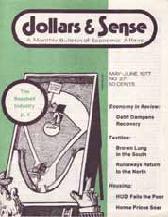This article is from the November 1977 issue of Dollars and Sense: The Magazine of Economic Justice available at http://www.dollarsandsense.org

This article is from the November 1977 issue of Dollars & Sense magazine.

Retrospective
Depreciating the National Pastime
Baseball Owners Hide Profits
Players hailed it as freedom, Oakland A’s owner Charley Finley said it’s “horse manure” and Bowie Kuhn, the Major League Commissioner, euphemistically called it “historic.” At any rate, this year’s introduction of a free agent draft to replace the now-illegal reserve clause (the system that gave each team unlimited rights to sell, trade, or hold onto its players) has meant big changes for baseball.
The newspapers are full of sensational stories on multimillion-dollar contracts and the owners continue to insist, as they always have, that freedom in the baseball labor market spells certain doom for the industry. Should we believe these gloomy predictions for our “national pastime”?
Today baseball is big business. But this was not always the case. The first baseball teams were the outgrowth of leisure clubs formed in the 1850s by wealthy men who enjoyed the new sport. These teams were cooperative ventures, owned and run by the players.
It wasn’t long before capital moved into the industry. The 1876 formation of the National League of Professional Base Ball Clubs was the formalization of what A. G. Spaulding (pioneer baseball entrepreneur) called “The irrepressible conflict between labor and capital… Like every other form of business enterprise, baseball depends for results on two interdependent divisions, the one to have absolute control and direction of the system, and the other to engage — always under the executive branch — in the actual work of production.”
Monopoly Game
In the last 100 years, the American League has made the only successful attack on the monopoly position of the National League. All other attempts, either by players, in reaction to low wages and oppressive working conditions, or by outside capital, hoping to cash in on big money, have been smashed.
In 1922, the Supreme Court legalized the Major Leagues’ monopoly by granting them an antitrust exemption on the grounds that baseball was not a “commercial enterprise.” This exemption remains the basis for territorial rights over the franchises (and therefore audiences) and, until last year, for monopoly rights over players — the reserve clause. It is also the basis for monopoly profits.
The most striking feature about the financial information on baseball is that it cannot be found. As Marvin Miller, executive director of the Major League Players’ Association, told D&S, “It’s the most secretive industry in the country.” Every year the owners plead their inability to pay salary increases. And every year they begin collective bargaining sessions with a speech guaranteeing they will not claim inability to pay, as this would require them to make full financial disclosures.
There are widely varying profit estimates, even from the clubs themselves. One year the Boston Red Sox reported a positive net income of $122,032 in Congressional hearings and a $616,640 loss in the Sporting News! Last year, the Commissioner’s office estimated yearly net profits of between $150 and $175 million, or $6 to $7 million per club. One economist calculated a net profit rate for an average American League club of 9 to 10 percent in bad years and 25 percent in good years. One can further assume that these figures are under-reported, due to inflated administrative costs and the treatment of interest and depreciation.
When a baseball team changes hands, the purchase prices must be allocated to various categories (the value of the franchise, broadcasting rights, players’ contracts, etc.) for tax purposes. Under IRS rules, player contracts can be depreciated — the annual decline in a player’s value can be figured as a cost to the owner. This is because players, unlike franchises or broadcasting rights, but like machines, wear out.
Bill Veeck, owner and baseball aficionado, said, “Selling a team is selling the right to depreciate.” The trick is to buy a baseball team and allocate as much of the purchase price as possible to player contracts. This technique reached its height in 1966, when the Atlanta Braves allocated 99 percent of the $6.1 million price of the team to players’ contracts. This worked out to allow $4.2 million in profits to go tax-free.
The IRS subsequently lowered the 99 percent figure to 90 percent, and this year’s tax reform contains some revisions, but they are minor. A Brookings Institution study concludes that the income that can be sheltered by depreciating player contracts exceeds any profits that the best-managed team can earn.
One effect of the depreciation laws has been to drastically raise the price of baseball teams. A 1971 study found that the average value of a team when its current owner bought it was $4 million in the National League and $6 million in the American League. By 1971, the average team was worth $13 million in the National League and $10 million in the American League.
A Few Financial Factors
Baseball players’ salaries capture the big headlines, but they are only a small part of the overall financial picture of the industry. Last year, for example, players’ salaries totaled about $30 million. Ball park concessions (peanuts, souvenirs, etc.) took in some $60 million, of which the clubs took $23 million. By this standard, one might judge that players’ salaries are roughly equivalent to peanuts, from owners’ point of view.
Owners took in another $50 million from the sale of local and network TV and radio rights. The role of RV and radio is continually growing in baseball, with the take from broadcast rights probably greater than one-third of the box office receipts. But owners cannot expand broadcasting indefinitely without cutting into game attendance. This could create a greater problem than players’ salary demands.
Another possible problem area is the cost of equipment ($500,000 for balls each year). Here the industry has gone multinational to take advantage of cheap labor costs. Haiti, for example, has been the primary source of baseballs. And, who knows, with U.S. power in world affairs on the wane, the day may come when baseballs’ owners plead with fans to give back foul balls and homeruns.
Higher prices have put baseball teams out of the reach of the average independent millionaire and into corporate hands. Anheuser-Busch owns the St. Louis Cardinals, Seagram’s the Montreal Expos, and Wrigley’s the Chicago Cubs. The San Diego Padres belong to McDonald’s. CBS, which owns the Yankees, pays itself for broadcasting rights.
Conglomerates
Big companies can take a loss on a team by depreciating the players and subtracting that loss from the income earned in other subsidiaries. And corporate owners are in a much better position to hold out against players’ demands during a strike (see D&S No. 25 on mergers).
Through a free advertising network (television and the sports page of every American newspaper) the owners accuse the players of destroying the game by forcing up ticket prices. At the opening Red Sox game this season, fans displayed a banner reading: “Sell Campbell and bring back $1.50 bleachers.” A few players like Bill Campbell win million-dollar contracts, and the owners portray themselves as impoverished victims committed to their “love of sport.”
Historically, players have never had a large share in the industry’s profits. From 1883 to 1950, gross receipts increased eightyfold as compared to a sevenfold increase in wages. The total proportion of costs going to wages has declined steadily, from over 50 percent in the 19th century to 35.5 percent in 1929, to 18.2 percent in 1972.
A Special Kind of Workers
The average salary for a professional baseball player in 1975 was $46,000 and the current negotiated minimum is $19,000. Superstars, of course, fare much better (because they are “irreplaceable commodities”). They can expect fancy jobs after retirement in baseball organization or other firms that want to capitalize on their names.
For most players, who put in the same years of training and face the same risks of costly and painful injury, there may be no forthcoming means of support after retirement. Career lengths average only 4 ¾ years for those who play at least 60 days. Even those players who are lucky enough to last 4 years and gain eligibility for the union pension fund average a total career span of 8 years. The latter group is disproportionately made up of white players.
Baseball is a line of work in which the bosses exert control over all aspects of the players’ lives including choice of friends, political stands, behavior to fans, appearance, etc. The Cardinals’ reaction to the free agent draft was a crackdown on players’ long hair and beards.
Are players’ demands really ruining baseball? Marvin Miller answered the question nicely: “Before the teams even open their parks they get back 150 percent of player salaries from radio and TV rights.” Now that’s the way to run a business.
Did you find this article useful? Please consider supporting our work by donating or subscribing.
